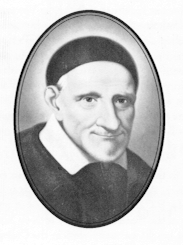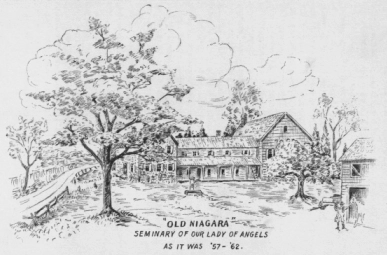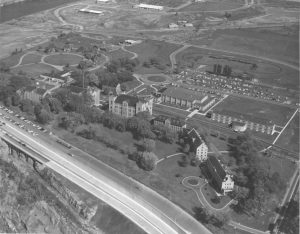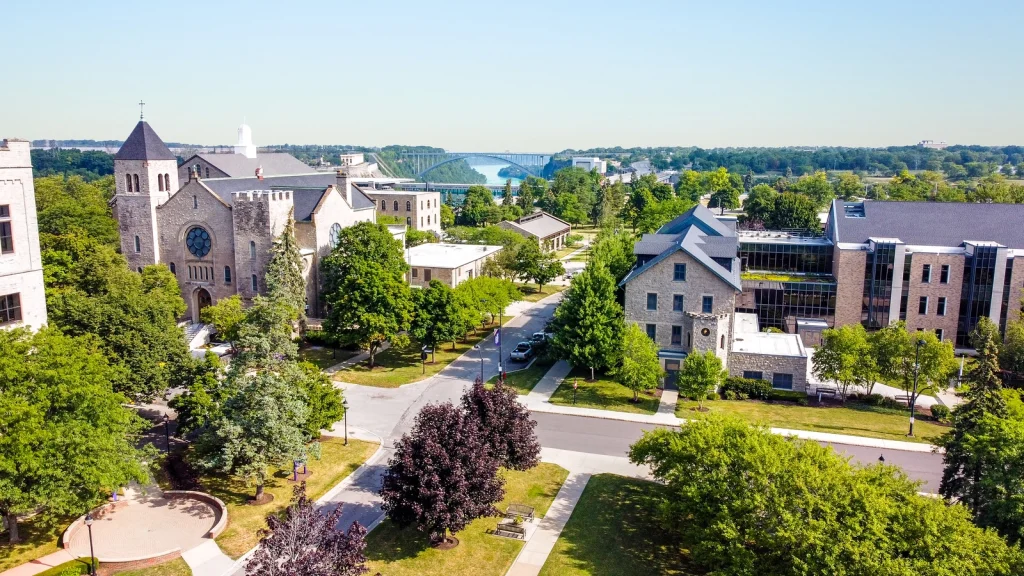How the School Was Founded
 Founded by the Vincentian Community in 1856, Niagara University is a private liberal arts university with a strong, values-based Catholic tradition. Its five academic divisions include the colleges of Arts and Sciences, Business Administration, Education, Hospitality and Tourism Management, and Nursing. The university also maintains an Academic Exploration Program that provides a learning community for students who are undecided about their major. Located on the Niagara River overlooking the Province of Ontario, Canada, the university is located at the northern limits of the City of Niagara Falls, N.Y., about four miles from the world-famous cataracts. More than 4,000 students are enrolled in its undergraduate and graduate programs.
Nov. 21, 1856, is generally regarded as the birthdate of Niagara University. On that day, six seminary students, accompanied by two faculty members, moved from the residence of the Most Rev. John Timon, C.M., the first bishop of the Diocese of Buffalo, into a vacated orphan home for boys on Best Street in Buffalo. The six-acre site, however, was less than ideal, and so the two Vincentian faculty members, Fathers John J. Lynch and John Monaghan, immediately began a search for a more ideal setting for the seminary.
During a visit to the Village of Suspension Bridge (now Niagara Falls) that same winter, they learned that the 100-acre Vedder farm, located a few miles north on Monteagle Ridge, was for sale. Negotiations ensued, and on Feb. 23, 1857, an agreement was reached for purchase of the property. Less than two months later, Father Lynch purchased the adjoining 200-acre DeVeaux farm complete with a barn and the two-story tavern known as The Half-Way House. On May 1, 1857, 23 weeks after its founding, the College and Seminary of Our Lady of Angels moved from Buffalo to its new home on Monteagle Ridge.
The barroom and bowling alley in The Half-Way House (named for its location between Suspension Bridge and Lewiston) became the sacristy and chapel, respectively. The attic, and later the barn loft, provided dormitory facilities. The fall of 1857 saw enrollment increase from six to 24 students. The following year it rose to 80, resulting in expansion of existing facilities. The year 1859 also saw Father Lynch, the university’s co-founder with Bishop Timon, appointed coadjutor bishop of Toronto, Ontario.
Founded by the Vincentian Community in 1856, Niagara University is a private liberal arts university with a strong, values-based Catholic tradition. Its five academic divisions include the colleges of Arts and Sciences, Business Administration, Education, Hospitality and Tourism Management, and Nursing. The university also maintains an Academic Exploration Program that provides a learning community for students who are undecided about their major. Located on the Niagara River overlooking the Province of Ontario, Canada, the university is located at the northern limits of the City of Niagara Falls, N.Y., about four miles from the world-famous cataracts. More than 4,000 students are enrolled in its undergraduate and graduate programs.
Nov. 21, 1856, is generally regarded as the birthdate of Niagara University. On that day, six seminary students, accompanied by two faculty members, moved from the residence of the Most Rev. John Timon, C.M., the first bishop of the Diocese of Buffalo, into a vacated orphan home for boys on Best Street in Buffalo. The six-acre site, however, was less than ideal, and so the two Vincentian faculty members, Fathers John J. Lynch and John Monaghan, immediately began a search for a more ideal setting for the seminary.
During a visit to the Village of Suspension Bridge (now Niagara Falls) that same winter, they learned that the 100-acre Vedder farm, located a few miles north on Monteagle Ridge, was for sale. Negotiations ensued, and on Feb. 23, 1857, an agreement was reached for purchase of the property. Less than two months later, Father Lynch purchased the adjoining 200-acre DeVeaux farm complete with a barn and the two-story tavern known as The Half-Way House. On May 1, 1857, 23 weeks after its founding, the College and Seminary of Our Lady of Angels moved from Buffalo to its new home on Monteagle Ridge.
The barroom and bowling alley in The Half-Way House (named for its location between Suspension Bridge and Lewiston) became the sacristy and chapel, respectively. The attic, and later the barn loft, provided dormitory facilities. The fall of 1857 saw enrollment increase from six to 24 students. The following year it rose to 80, resulting in expansion of existing facilities. The year 1859 also saw Father Lynch, the university’s co-founder with Bishop Timon, appointed coadjutor bishop of Toronto, Ontario. NU Growth
In response to the growing number of collegians and seminarians, a new building was constructed in 1862 to serve as the administration-seminary building. The following year, on April 20, 1863, the New York State Legislature granted a charter empowering the College and Seminary of Our Lady of Angels to confer degrees upon its graduates.

Seminary of Our Lady of Angels
Disaster Struck
Disaster struck on Dec. 5, 1864, when fire destroyed the administration-seminary building. As a result, the school was forced to close. Reconstruction began in April of 1865 and the school reopened in September of that year.
25th Anniversary
On the occasion of Niagara’s 25th anniversary on Nov. 21, 1881, Bishop Stephen V. Ryan, C.M., provincial superior of the American Vincentians at the time of his appointment as the second bishop of Buffalo, congratulated the college and seminary, which had graduated 300 priests, 25 doctors, 47 lawyers, 40 professors, 15 newspaper editors, 25 brokers, 245 merchants, many members of the Legislature, and hundreds in other walks of life.
Niagara Gets Its Name
On Aug. 7, 1883, New York Gov. Grover Cleveland signed the documents that erected the College and Seminary of Our Lady of Angels into Niagara University, though the name of the seminary was preserved. The seminary remained at Niagara until 1961, when it was moved to Albany. It has since closed.

Aerial image of Niagara University in 1962
Over the years, Niagara has evolved into a comprehensive university, offering more than 50 professional and career-oriented programs for its 2,700-plus undergraduates. More than 900 graduate students are enrolled in a variety of programs in the College of Education and in master’s programs in business, criminal justice, information security and digital forensics, and interdisciplinary studies.
True To Our Roots
True to the spirit of St. Vincent de Paul, founder of the Vincentian Community and universal patron of charitable works, Niagara maintains a comprehensive, academically grounded and career-oriented community service program. Annually, Niagara University students contribute more than 50,000 hours to the local neighborhoods through their community service and through the service learning experiences of our university-wide IMPACT program.
IMPACT builds confidence, clarity of direction and a heightened sense of purpose by providing NU students with career preparation through service, and connects students to service opportunities in which they can utilize the skills and knowledge that they learn in the classroom and apply them in a hands-on, real-world setting. NU students are active in almost 300 social service and community agencies in Western New York and southern Ontario.
Service learning promotes the mission of Niagara University by enhancing students’ academic skills and lifelong learning, by promoting and working towards social change, and by attempting to instill in students the value of transformative service to others.
The Campus
 More than two dozen buildings dot the picturesque Niagara University campus.
More than two dozen buildings dot the picturesque Niagara University campus.
- In 2001, the university completed an $11 million renovation of one of its more historic buildings, St. Vincent’s Hall. Built in 1905, the four-story, collegiate Gothic-style building was gutted and returned to service in less than nine months. It now houses a ground floor devoted to information technology, two floors of classrooms with the latest in instructional technology, and a fourth floor, featuring a large atrium, that serves as home of the College of Hospitality and Tourism Management.
- In the fall of 2002, an $11 million apartment-style housing complex opened on campus.
- The university completed an expansive $80 million capital campaign in 2012, the results of which include the new Academic Complex and adjacent Bisgrove Hall, a residence for the Vincentians, a renovated theatre, state-of-the-art B. Thomas Golisano Center for Integrated Sciences, and several other additions.
- In September 2014, NU held a blessing and dedication to the renovated hub for admissions and alumni engagement Gacioch Family Alumni and Admissions Center, formerly Meade Hall, which was made possible by a $2 million gift from William Gacioch.
- The Russell J. Salvatore Dining Commons at Niagara University underwent an $8 million renovation and expansion, which was completed in January 2017.
- In Fall of 2023, an $11.5 million renovation of the Kiernan Recreation Center was completed. The biggest change to the center is the addition of 18,000 square feet that houses a new weight room, sports medicine suite, advanced dance studio, a spin class studio, athletic locker rooms, field and classroom storage, a meeting space for Niagara’s athletic teams, coaches offices, and recreation offices.
The Students
70% of Niagara’s students come from New York state, with over half of that number from Niagara and Erie counties (60%). About 7% are from out of state and 23% are from Canada and other foreign countries. The College of Education has a large Canadian enrollment in its graduate programs in education. Niagara is the only Western New York college or university with ministerial consent to offer its programs in the Province of Ontario. About 1,200 students live on the NU campus.
The Sports
Niagara competes in 19 Division I NCAA sports as a member of the Metro Atlantic Athletic Conference. NU’s men’s hockey team plays in the Atlantic Hockey Association. Among Niagara’s sports legends are National Basketball Association Hall of Fame member Calvin Murphy, former Utah Jazz coach and president Frank Layden, former New York Knicks and Memphis Grizzlies coach Hubie Brown and the late Larry Costello, former coach of the Milwaukee Bucks.
